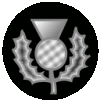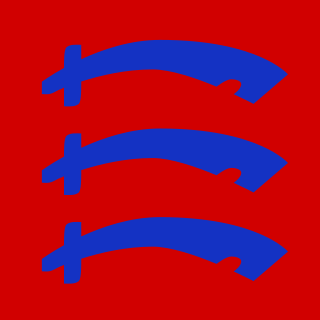
The 9th (Scottish) Division, was an infantry division of the British Army during the First World War, one of the Kitchener's Army divisions raised from volunteers by Lord Kitchener to serve on the Western Front during the First World War.

The 61st Division was an infantry division of the British Army raised in 1915 during the Great War as a second-line reserve for the first-line battalions of the 48th Division. The division was sent to the Western Front in May 1916 and served there for the duration of the First World War.

The 32nd Division was an infantry division of the British Army that was raised in 1914, during the First World War. The division was raised from volunteers for Lord Kitchener's New Armies, made up of infantry 'Pals battalions' and artillery brigades raised by public subscription or private patronage. The division was taken over by the War Office in September 1915. It served in France and Belgium in the trenches of the Western Front for the duration of the war. It saw action at the Battle of the Somme, the Pursuit to the Hindenburg Line, the Defence of Nieuport, the German spring offensive, and the Allied Hundred Days Offensive beginning at the Battle of Amiens. After the Armistice it marched into Germany as part of the Army of Occupation.

The Seaforth Highlanders was a line infantry regiment of the British Army, mainly associated with large areas of the northern Highlands of Scotland. The regiment existed from 1881 to 1961, and saw service in World War I and World War II, along with many smaller conflicts. In 1961 the regiment was amalgamated with the Queen's Own Cameron Highlanders to form the Queen's Own Highlanders, which merged, in 1994, with the Gordon Highlanders to form the Highlanders. This later joined the Royal Scots Borderers, the Black Watch, the Royal Highland Fusiliers and the Argyll and Sutherland Highlanders to create the present Royal Regiment of Scotland.
The 26th Infantry Brigade was the name of two British Army formations during the First World War and Second World War.
The 28th Division was an infantry division of the British Army raised for service in World War I.

152nd Infantry Brigade was a formation of Britain's Territorial Force/Territorial Army that was part of 51st (Highland) Division in both World Wars. From its origins in the 19th Century Volunteer Force it was based in Inverness and was composed of Highland battalions. It served on the Western Front in World War I, and after it was captured at Saint-Valery-en-Caux early in World War II it was reformed from its 2nd Line and saw action in North Africa, Sicily and North West Europe.

153rd Infantry Brigade was a formation of Britain's Territorial Force/Territorial Army that was part of 51st (Highland) Division in both World Wars. From its origins in the 19th Century Volunteer Force it was based in Aberdeen and was composed of Highland battalions. It served on the Western Front in World War I, and after it was captured at Saint-Valery-en-Caux early in World War II it was reformed from its 2nd Line and saw action in North Africa, Sicily and North West Europe. It continued serving postwar until the reduction of the Territorial Army in the 1960s.

154th Infantry Brigade was a formation of Britain's Territorial Force/Territorial Army that was part of 51st (Highland) Division in both World Wars. From its origins in the 19th Century Volunteer Force it was based in Stirling and was composed of Highland battalions. It served on the Western Front in World War I, and after it escaped from France early in World War II it was reformed from its 2nd Line and saw action in North Africa, Sicily and North West Europe. It continued serving postwar until the reduction of the Territorial Army in the 1960s.
The 46th Infantry Brigade was an infantry brigade of the British Army that saw active service in both the First and the Second World Wars with the 15th (Scottish) Infantry Division.
The 157th Brigade was an infantry brigade of the British Army. The brigade fought in both the First and the Second World Wars, assigned to 52nd (Lowland) Infantry Division.
The Liverpool Brigade, later 165th (Liverpool) Brigade was an infantry brigade of Britain's Volunteer Force that served during World War I with the 55th Division of the British Army. During World War II, again as part of the 55th Infantry Division, the brigade remained in the United Kingdom.
The 63rd Division of the British Army was a second-line Territorial Force division, formed in 1914, which served on home defence duties during the First World War. The division was formed as a duplicate of the 50th (Northumbrian) Division in 1914, composed primarily of soldiers recruited in north-eastern England. It remained on home defence and training duties in the north-east and east of England until 1916, when it was disbanded. Several of its constituent units would later serve overseas, deployed for support and garrison duties in almost every theatre of the war.
The 65th Division of the British Army was a second-line Territorial Force division, formed in 1914, which served on home defence duties during the First World War.
The 196th Brigade was an infantry brigade of the British Army raised during the Great War in 1914. The brigade was formed as a 2nd Line of the 157th Brigade and assigned to the 65th Division, itself formed as a 2nd Line of the 52nd (Lowland) Division. The brigade was composed of four 2nd Line battalions of the Highland Light Infantry and remained in the United Kingdom throughout the war.
221st Mixed Brigade was a Scottish Home Service formation of the British Army that served under various titles throughout World War I.

The 223rd Brigade was a Home Defence formation of the British Army in the First and the Second World Wars. It existed under several variations of the 223 Brigade title, and was eventually converted into an airborne formation.
The Black Watch Brigade was a Territorial Force infantry brigade of the British Army. Formed in 1908, it was not part of any division, instead being assigned to Coastal Defence duties in Scottish Command. It was dissolved in early 1915 as its constituent battalions were posted to other formations.
The 2/1st Black Watch Brigade was a 2nd Line Territorial Force infantry brigade of the British Army in World War I. The brigade was formed as a duplicate of the Black Watch Brigade in January 1915. As the name would suggest, it was organized with four battalions of the Black Watch, It was dissolved in November 1915 as its constituent battalions were posted to other formations.

The Highland Cyclist Battalion was a bicycle infantry battalion of the Territorial Force, part of the British Army. Formed as part of the Volunteer Force in 1860, it became a Volunteer Battalion of the Black Watch in 1881. In 1909 it became an independent unit and served in the United Kingdom throughout the First World War. In 1920 it was converted as part of the Highland Divisional Signals.






